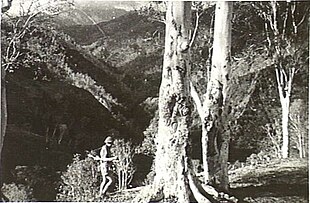Battle of Timor
| Battle of Timor | |||||||
|---|---|---|---|---|---|---|---|
| Part of the Pacific Theatre of World War II | |||||||
 An Australian commando, possibly Sergeant Bill Tomasetti of the 2/2nd Independent Company, in typical mountain terrain on Timor, on 12 December 1942. (Photograph by Damien Parer.) |
|||||||
|
|||||||
| Belligerents | |||||||
|
|
|
||||||
| Commanders and leaders | |||||||
|
|
(invasion) (later campaign) |
||||||
| Strength | |||||||
| ~ 2,050 strong garrison (peak February 1942) ~ 1,000 commandos (peak October 1942) |
~ 12,000 (peak late 1942) | ||||||
| 500 | |||||||
| Casualties and losses | |||||||
|
Netherlands: ~ 300 dead Australia: 151 dead (Sparrow Force) Portugal: ~ 75 dead United Kingdom: 5 dead (The Sparrows) |
~ 4,000 dead (West & East Timor) |
||||||
| 40,000–70,000 civilian dead | |||||||
The Battle of Timor occurred in Portuguese Timor and Dutch Timor during the Second World War. Japanese forces invaded the island on 20 February 1942 and were resisted by a small, under-equipped force of Allied military personnel—known as Sparrow Force—predominantly from Australia, United Kingdom, and the Netherlands East Indies. Following a brief but stout resistance, the Japanese succeeded in forcing the surrender of the bulk of the Allied force after three days of fighting, although several hundred Australian commandos continued to wage an unconventional raiding campaign. They were resupplied by aircraft and vessels, based mostly in Darwin, Australia, about 650 km (400 mi) to the southeast, across the Timor Sea. During the subsequent fighting the Japanese suffered heavy casualties, but they were eventually able to contain the Australians.
The campaign lasted until 10 February 1943, when the final remaining Australians were evacuated, making them the last Allied land forces to leave South East Asia following the Japanese offensives of 1941–42. As a result, an entire Japanese division was tied up on Timor for more than six months, preventing its deployment elsewhere. Although Portugal was not a combatant, many East Timorese civilians and Portuguese European colonists fought with the Allies, or provided them with food, shelter and other assistance. Some Timorese continued a resistance campaign following the Australian withdrawal. For this, they paid a heavy price and tens of thousands of Timorese civilians died as a result of the Japanese occupation, which lasted until the end of the war in 1945.
By late-1941, the island of Timor was divided politically between two colonial powers: the Portuguese in the east with a capital at Dili, and the Dutch in the west with an administrative centre at Kupang. A Portuguese enclave at Ocussi was also within the Dutch area. The Dutch defence included a force of 500 troops centred on Kupang, while the Portuguese force at Dili numbered just 150. In February, the Australian and Dutch governments had agreed that in the event Japan entered the Second World War on the Axis side, Australia would provide aircraft and troops to reinforce Dutch Timor. Portugal—under pressure from Japan—maintained its neutrality. As such, following the Japanese attack on Pearl Harbor, a small Australian force—known as Sparrow Force—arrived at Kupang on 12 December 1941. Meanwhile, two similar forces, known as Gull Force and Lark Force, were sent by the Australians to reinforce Ambon and Rabaul.
...
Wikipedia
